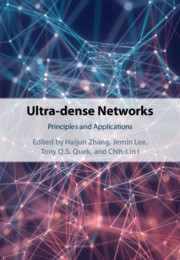Book contents
- Frontmatter
- Contents
- List of Contributors
- Part I Overview
- Part II Physical Layer Design
- 3 NOMA-Based Ultra-dense Networks
- 4 Physical Layer Security in Ultra-dense Networks
- 5 Millimeter-Wave Multiantenna Ultra-dense Networks
- 6 Interference Management in Ultra-dense Networks
- 7 3D-Based Base Station Deployment in Ultra-dense Networks
- 8 Power Control in Full-duplex Ultra-dense Heterogeneous Networks
- Part III Resource Allocation and Network Management
- Part IV Field Trials and Tests
- Index
3 - NOMA-Based Ultra-dense Networks
from Part II - Physical Layer Design
Published online by Cambridge University Press: 12 October 2020
- Frontmatter
- Contents
- List of Contributors
- Part I Overview
- Part II Physical Layer Design
- 3 NOMA-Based Ultra-dense Networks
- 4 Physical Layer Security in Ultra-dense Networks
- 5 Millimeter-Wave Multiantenna Ultra-dense Networks
- 6 Interference Management in Ultra-dense Networks
- 7 3D-Based Base Station Deployment in Ultra-dense Networks
- 8 Power Control in Full-duplex Ultra-dense Heterogeneous Networks
- Part III Resource Allocation and Network Management
- Part IV Field Trials and Tests
- Index
Summary
This chapter investigates the application non-orthogonal multiple access (NOMA) in heterogeneous ultra-dense networks (HUDNs).Particularly, we propose a unified NOMA framework first. Then the applications of the proposed unified NOMA framework in HUDNs will be discussed. With the fact that small cells are densely deployed and the non-orthogonality of resource sharing, the system suffers severe interference. In this chapter, we identify the key challenges in the unified NOMA enabled HUDNs, especially for user association and resource allocation. In addition, we carry out the related case studies for the proposed unified NOMA enabled HUDNs including the user association based on matching theory and resource allocation based on optimization techniques. Furthermore, some critical insights will be provided for the design of NOMA enabled HUDNs, which can promote network access capacity in the next generation of communication systems.
Keywords
- Type
- Chapter
- Information
- Ultra-dense NetworksPrinciples and Applications, pp. 37 - 50Publisher: Cambridge University PressPrint publication year: 2020

